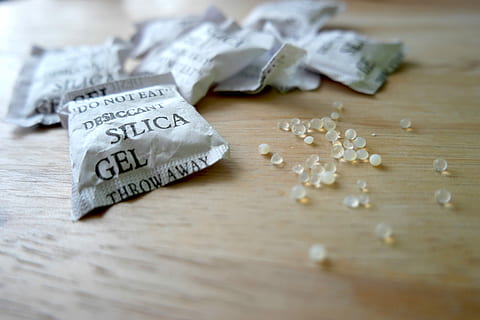Silica gel is found in food jars, clothes, or shoe boxes, its main work is to absorb moisture from the boxes. They always come with a don’t eat warning which is the main reason why many dog parents panic when their dogs eat silica gel. But, will it kill your dog?
Will Silica Gel Kill My Dog?
Do not panic if your dog ate silica gel because it is made of non-toxic substances. The substances are inert and will pass through the digestive tract without being digested. The situation can be dangerous if your dog took a lot of silica gel and its packaging which can lead to GI obstruction. This can also be the case if your dog ate a bottle of tums.
My Dog Ate Silica Gel, What Should I Do?
If your dog ate only silica gel beads, you should not be nervous because they are not toxic. Nevertheless, you should consider the amount of silica gel consumed with the size of your puppy. But, if he took only one sachet it shouldn’t bother you.
If the silica gel was from a box/jar with a poisonous product, you should inform the Pet Poison Hotline or your vet immediately.
In other instances, the silica gel can contain dyes that can be harmful to your dog. These dyes act like moisture indicator which changes color to blue, pink, or green. If you suspect the silica gel consumed by your doggie had dyes, contact your vet.
My Dog Ate Silica Gel Packet, What Should I Do?

The Silica gel packet is more harmful than the silica gel. If you get your dog in the process of swallowing the packaging and is suffocating, try to remove it using a spoon or fingers. Be careful because he can get aggressive out of panic.
You should observe your dog for any abdominal discomfort and take him to a vet. Note that it can lead to obstruction.
My Dog Ate Silica Gel What Will Happen?
In some unfortunate circumstances, silica gel consumption can lead to intoxication, obstruction, and dehydration.
Reads on to understand better on these symptoms so you can take the necessary actions.
Intoxication
Intoxication can be a result of the moisture indicator or the contents packed with the silica gel. Dyes can cause allergic responses, intoxication, dermatitis, or other unforeseen effects depending on the dog.
Dangerous foods and items containing silica gel can be fatal to your dog.
The aroma will drive your dog to the silica gel, but they won’t be able to tell the difference between a harmful and a non-toxic substance. It’s your duty to keep it out of their reach.
Intoxication in dogs exhibits itself in the following ways:
- Throwing up
- Nausea
- Stools with blood in them (extremely dark/black stools)
- Pale gums
- Fatigue
- Seizures
- Collapse
Dehydration
A dog who vomits or has diarrhea as a result of poor digestion can soon become dehydrated. Dehydration is extremely dangerous for your dog, and it will require instant medical attention.
If your dog becomes very dehydrated, its organs will be unable to operate correctly due to a lack of electrolytes, which could result in shock.
The following are signs of extreme dehydration in dogs:
- Lethargy
- The eyes, mouth, and nose are all dry.
- Elasticity is lost in the skin.
- Weakness
- Gums that are bright crimson
- Heart rate increase.
- Excessive breathing
Your dog’s dehydration can be detected in one of two ways: by examining their skin or by inspecting their gums.
Skin test
Gently pinch your dog amid his shoulders and lift it a few inches. Observe the duration it takes before it gets back to its normal state. If it gets back immediately, it means your dog is hydrated.
If the skin takes some time before it regains its normal state that means it is dehydrated.
Gum Test
Confirm the color of your dog’s gum first Press down on the gums with your index finger until they turn white.
If your dog is hydrated the gum will retain its color immediately you remove the finger but for a dehydrated dog, it will take some seconds.
A dehydrated dog should be taken to the vet immediately and given a lot of water.
GI Obstruction
If your dog consumed silica gel packaging, it will lead to GI obstruction. The severity of the harm is determined by the number of sachets consumed.
Some of the signs and symptoms of a gastrointestinal blockage in dogs are as follows:
- Throwing up
- Diarrhea
- Constipation
- Fatigue
- Loss of appetite
- Weakness
- Dehydration
- Bloating
- Pain in the abdomen
GI obstruction is the most prevalent condition in dogs after dangerous ingestions; it may resolve on its own, or it may require surgery to remove the sachets.
Surgery is painful, and the results might be uncertain in older dogs or those with pre-existing problems.
Conclusion
Dogs should not eat silica gel, though it contains nontoxic substances the silica gel packaging is not safe.
You should ensure that your dog is locked in a crate whenever you are unpacking new products that might contain silica gel. After unpacking, keep the silica gel far away.
Other Related Articles;

